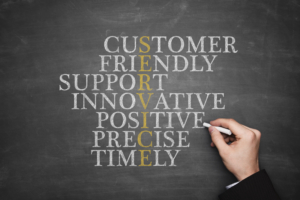Is your customer journey destined for success?
 Being in peak festive season and amidst an erratic pandemic, is the experience you provide to your customers making you stand out in a crowd or is it sending you along a route of reputational ruin?
Being in peak festive season and amidst an erratic pandemic, is the experience you provide to your customers making you stand out in a crowd or is it sending you along a route of reputational ruin?
Historically customer service has been built on the premise that the “customer is King” and the “customer is always right” and huge household brands have built their success on this very ethos, earning their place as top names within their specific sector.
During recent years customer experience has taken a step back, as companies have placed a higher emphasis on speed of service, over customer satisfaction. Over time, rightly or wrongly, we have accepted this change and a lower standard of customer service has become the normal. Very often, we as consumers perpetuate this by forgoing service levels for a cheaper price or because our lives are just too busy, or we feel uncomfortable to provide valuable feedback. But all that is changing as consumers are becoming increasingly empowered to not only take their business elsewhere but also to share bad experiences on review forums or social media sites.
The experience you give to your customers is the silver bullet in your armoury. The perception that you create for your customers will either make or break your brand and your bottom line. Because whether we like it or not, reputation sticks. Many organisations take advantage of their customers, presuming they will always be there and spend very little time nurturing the meaningful relationships that ultimately drive success. Whether you provide an inadequate customer experience or you have failed to take the time to make your customers feel special, it will only be a matter of time before that customer chooses to source their product or service from a different provider. However, making your customers feel valued is worth its weight in gold. It has been suggested that a over 90% of people are more likely to be repeat customers if they receive excellent customer service. What would that mean to your business if 90% of your customers were repeat purchasers? Instead of trying to drive short-term success or adopt quick fixes, consider the long-term goal, which should include a clear customer service strategy and consistent customer values that are orchestrated by business leaders and adopted throughout the business. And during the current pandemic, strategies will have to be re-addressed to ensure your customer service offering isn’t being impaired through working from home activities.
During this time of uncertainty, customers exercise caution about if, how and where to spend their money. You have to make it an easy and enjoyable experience in order to see customers return. There is no doubt that Covid-19 will be a huge driving force to re-elevate customer experience. Companies are now looking at ways to enhance their customer experience and are achieving this through a blend of people investment and bespoke digital platforms. The human element is still critical to the customer service process and developing a stronger brand, but we cannot ignore the value that comes from combining your workforce with feature rich technology. In a recent study, 71% of IT decision makers found that automation has helped their company remain more agile during the Coronavirus pandemic and 64% of those will be looking to increase their investment further during the coming 12 months. Now is the time to evaluate how your customers perceive your business and to take the necessary steps to secure the future of your brand.
Technology can play an important role to help you meet the needs of your customer, but use it as a stepping-stone in your overall customer strategy. Human contact is still vital in providing a personalised service that will see customers return again and again. In order to succeed at every step, you need to evaluate every element of your operation to ensure it is exceeding the expectations of your customer. If you don’t, you may find that areas such as delivery are fracturing your customer journey, costing you vital reputation points and impacting you financially. Organisations need to move from thinking of their customers as an “account number” or “order number”, to remembering that they are human beings.
Customers expect agility, responsiveness and for the company they are buying from to really care about their transaction. In order to drive the lifetime value of your customer and increase overall retention, you need to have a clear strategy and the investment to consistently nurture and delight your existing customer base. Promotions and incentives ae a great way to drive new business but that alone will not encourage loyalty to your brand. When the incentive ends, more likely than not, so will your relationship – unless you take the time to make the customer feel valued and respected. Earning a customer’s business is one thing but earning that customers repeat business is something else. It is worth remembering that if you don’t look after your customer, someone else will.










